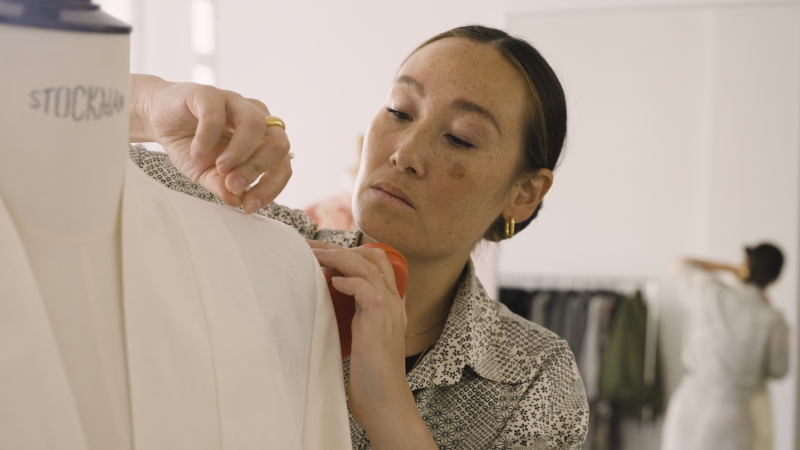We have associated the phrase “Crafted in Japan” with the Mazda CX-60, but why? At Mazda we don’t just ‘make’ our cars, there is passion, dedication and craftmanship that goes into every vehicle. This ethos of hand-made, premium quality is firmly established in Japanese culture.
This can be seen at the very first stage of visualisation, when our artists create physical models to inspire the designers. Mazda’s Takumi modelers cut and mould the shape of the cars from clay using traditional tools before metalworkers file and shape the metal by hand to give the desired reflective surface.
This craftmanship is further represented in the interior of the CX-60. The traditionally made door fabric reacts sensitively to changes in light and the Japanese needlework known as Musubu creates hanging stitches, which can be seen in the Takumi model’s dash panel. The maple wood trim in the Takumi is crafted in the Hacho style, which means ‘asymmetrical balance’- hand-made initially and then replicated for mass production.

In Japanese culture the craft should be intended for, and be able to withstand the rigours of, daily use, it must be created using traditional techniques and methods and the main materials should remain true to their historical context. Attention to detail is essential in Japanese craftmanship, but it’s not just the physical that is important, but also consideration of the surrounding space and the light. Often the most important part of Japanese design is what is not there and the way an artist creates meaningful space or how light is reflected and flows through an object to add tone and substance.
This is integral to the Mazda design philosophy of “beauty by subtraction” and how the creation of our cars use all the elements typical of Japanese craftmanship, from the functional engine and technology to the way the car looks and how it plays with light to reflect its surroundings in a way no other car can. We use clay to create the shape, similar to the artists that made Japanese ceramic and pottery ware famous, we use metal workers using traditional methods to shape the body and we create fabrics that follow age-old techniques and reflect the art of Japanese stitching, keeping true to traditional craft and culture. This is why we refer to our cars as ‘crafted in Japan’.
Taking this inspiration from traditional Japanese craftmanship, we are able to define Mazda in way that positions us in a uniquely Japanese premium territory. And to celebrate the launch of the Mazda CX-60 in conjunction with Time Out we have highlighted the work of four artisans inspired by Japanese craft who’s work can be seen at our UK Mazda CX-60 press launch and who’s bios are included below:
SUSUMU AI

SUSUMU AI is a Japanese – German fusion brand that offers a range of clothing using carefully selected sustainable high-quality fabrics sourced entirely from Japan. In addition, the brand uses leftover fabrics to create smaller accessories and pieces such as masks, scrunchies and key chains to minimise fabric waste.
Based in Berlin, Germany, founders Alisa and Keiho Menkhaus were raised with both Japanese and German roots, and in each country, always perceived as foreigners. SUSUMU AI has a strong family background with its direct translation meaning “continuous love”, whilst ‘SUSUMU (進)’ also plays tribute to Alisa and Keiho Menkhaus’ Japanese grandfather’s name, whose constant motivation and love – even beyond his passing away – breathes life into the clothing brand.
SUSUMU AI is a perfect expression of continuous family love. It is the devotion to detail, preservation of Japanese craft, their grandfather’s influence, and the vision of these siblings that create SUSUMU AI.
Kei Tominaga

Kei Tominaga is a metalwork designer and sculptor originally from Tokyo, now based in London. After studying metal sculpture and smithing at the Tokyo University for Art and Music and then later completing her masters, Kei started to experiment with product design in order to bring her work to a wider audience.
Her latest work of metalworks, silverware and jewellery are a departure from her both traditional metal smithing and product design background, and with each piece handmade by Kei, her products have lightness and textures of paper and fabric, giving uniqueness to her simple and pure designs in precious metals. In addition to designing several solo contemporary product collections, Kei has collaborated with several global architects and designers, plus featured in many international design exhibitions including the “TUKURU” exhibition as part of the Clerkenwell Design Week and “Craft by Residency“ in previous London Craft Week.
“I like to work with sheet metals, especially soft metals such as silver, gold, copper and iron. They are much better and more flexible than we generally think they are, so I work with metal exactly as I work with other everyday materials such as paper or fabric,” says Tominaga.
“I cut, bend, fold, curve and stick them together, narrowing down the techniques in the process so the result is as simple as possible. I think it gives the object a strength that is simple and pure. I like sharp, straight edges just like folded paper. Completely flat faces or tightly curved edges give my work strength and tension.”
Ikuko Iwamoto

Ikuko Iwamoto is a London-based Japanese artist who uses porcelain to create eccentric table top pieces and sculptures. With pottery and porcelain one of the oldest Japanese crafts and art forms (dating back to the Neolithic period), Ikuko’s fundamental inspiration comes from intricate and fragile looking structures, and odd forms found in microscopic world.
Her typical work involves using a slip-casting technique, which process includes plaster model and mould making to create a hollow body, and spikes and piled-up dots are often obsessively attached to create tension, fragility and flows.
Also, additional materials such as coiled telephone cables, metal wires, and needles are frequently incorporated into her porcelain forms with her wall piece sculptures.
KANPAI

Based in South London, KANPAI is the UK’s first sake brewery and specialises in crafting British-style sakes using traditional Japanese techniques. Translating to “dry your cup” or “cheers” in Japanese, KANPAI brew, bottle and package every drop themselves to ensure the highest quality; a true craft hands-on operation.
Founded in 2016 by husband and wife, Tom and Lucy Wilson, KANPAI is experimental at heart and ongoing exploration forms a huge part of their motivation to brew sake in the UK. After honing their skills at a brew school in Japan, KANPAI sake is made from just four simple ingredients: rice, water, yeast and koji (a unique mould also used to make things such as soy sauce) and produced by hand using low interventionist brewing methods to allow the natural characteristics of each ingredient to shine through.
“We enjoy the delicate intricacies of traditional Japanese sakes – the art of hundreds of years brewing, which are the perfect light friend to sushi or ramen. But we’re putting a twist on things – exploring more full-bodied and boundary-pushing flavours to suit the palates of those that love craft beers, high-botanical gins and rich red wines. The type of sakes that can stand up to a Sunday roast or enhance your curry”, explains KANPAI.



